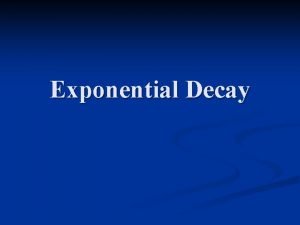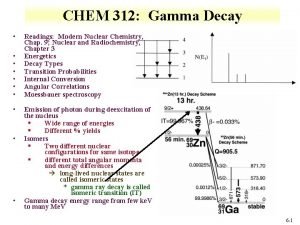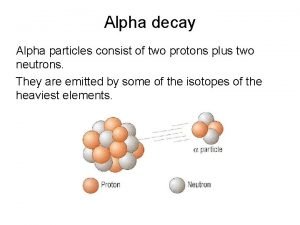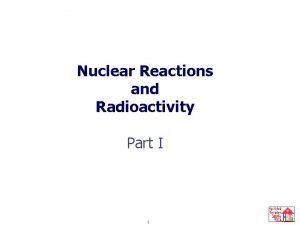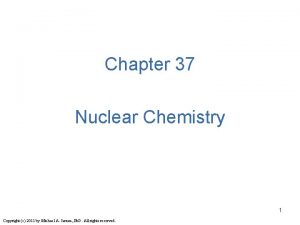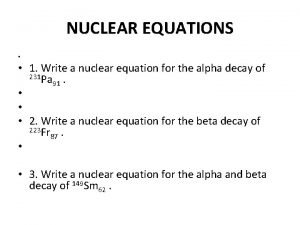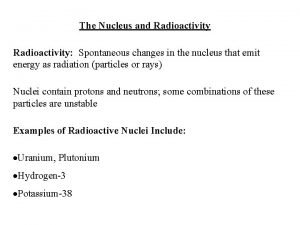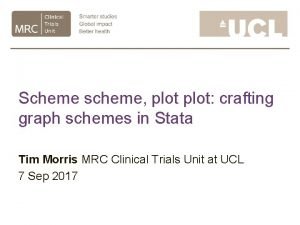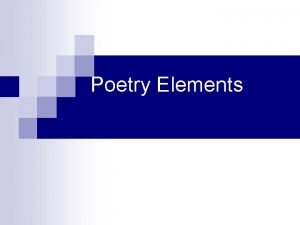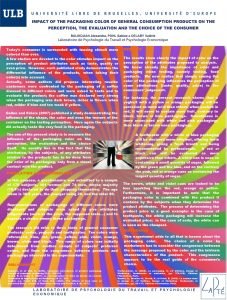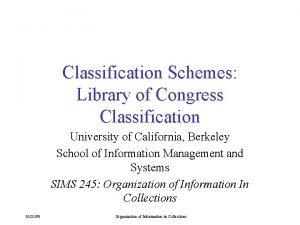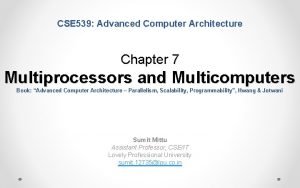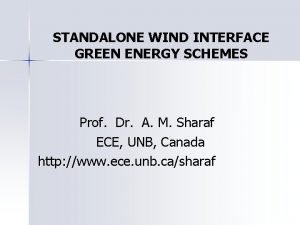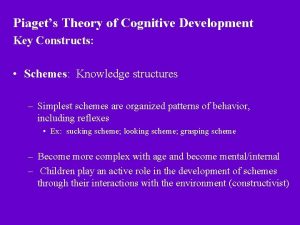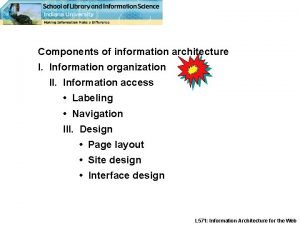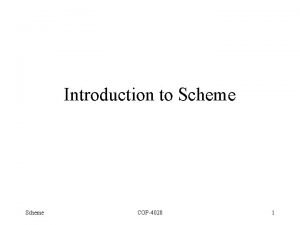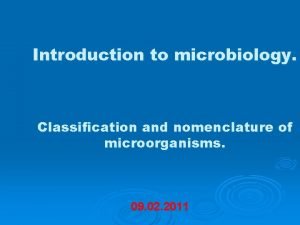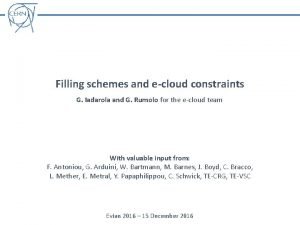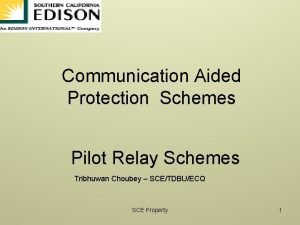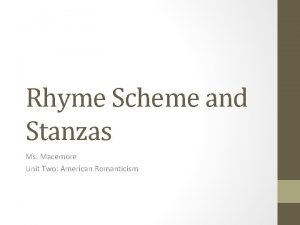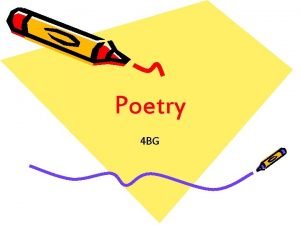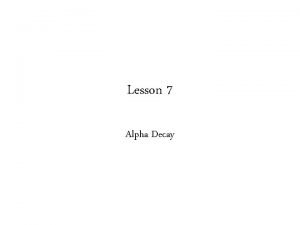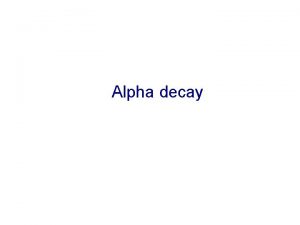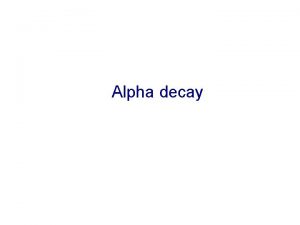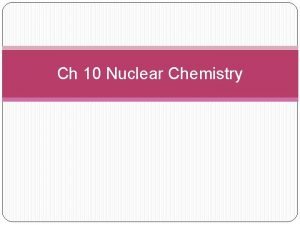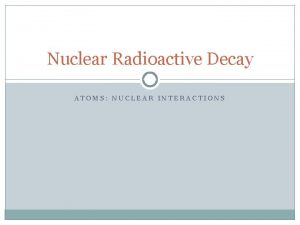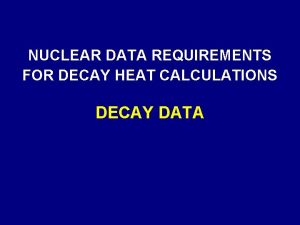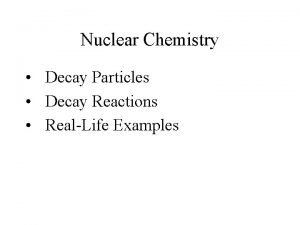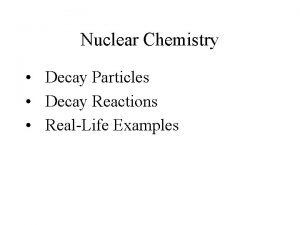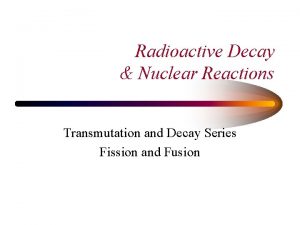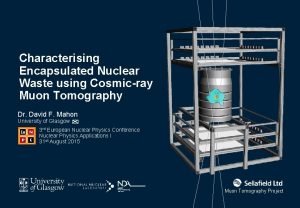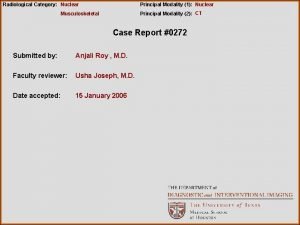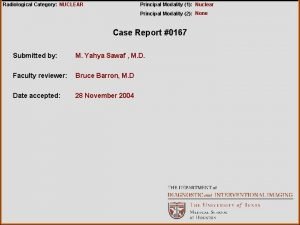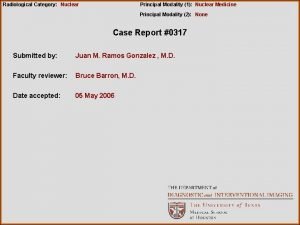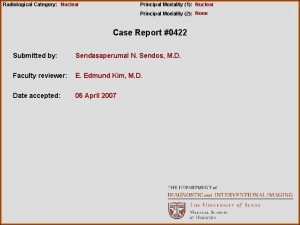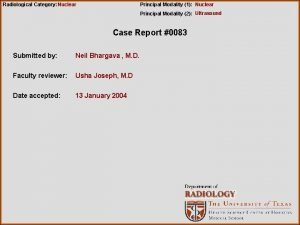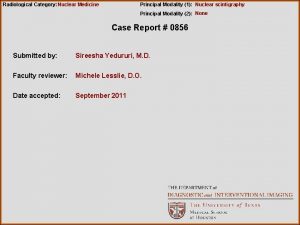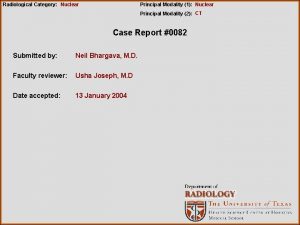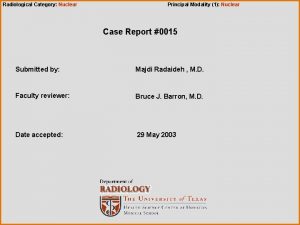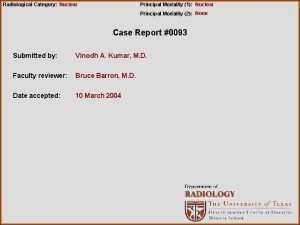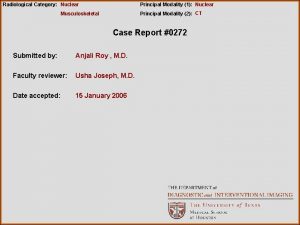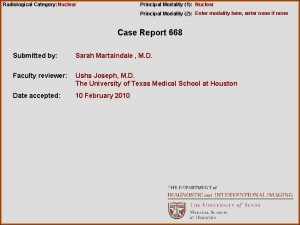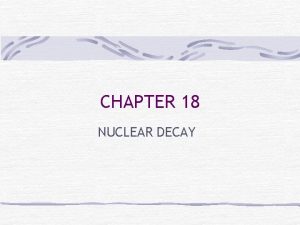Characterising Nuclear Decay Schemes Nuclear Structure to Radiological











































- Slides: 43

Characterising Nuclear Decay Schemes: Nuclear Structure to Radiological Standards Paddy Regan Department of Physics, U. Surrey, UK p. regan@surrey. ac. uk & Nuclear Metrology Department, National Physical Lab. UK, paddy. regan@surrey. ac. uk

Outline: • Introduction to radioisotope physics • Some Current frontiers: • Gamma-ray energies and electromagnetic transition rates • Reaction/production mechanisms • Nuclear shape/shell evolution E(2+) evolution. • Gamma-ray Detection - Singles and Coincidence Arrays: • NORMs • The DESPEC/FATIMA array at GSI/FAIR for DESPEC experiments. • Pre-DESPEC with EURICA: deformation in 104, 6 Zr ( - timing). • Nu. BALL at IPN-Orsay, 164 Dy(18 O, 16 O)166 Dy. • Applications / impact at NMIs for absolute standards. • NORM measurements (mining; 223 Ra radioisotope standards). • NANA for 60 Co standardisation; 90 Sr → 90 Y → 90 Zr ’imaging’.

By 1930, the main ‘NORM’ decay chains were characterised….

Naturally Occurring decay ‘chains’ (NORMs). Sequences of and decaying radioisotopes from Uranium (Z=92) or Thorium (Z=90) to Lead (Z=82). On earth since formation. Isotope/element ratios (e. g. can be used to date rocks / earth etc. . 206 Pb/238 U)



‘new’ radioisotopes still being discovered ….

Different nuclear reaction mechanisms? • • Heavy-ion fusion-evaporation reactions (neutron-deficient). Spontaneous fission sources such as 252 Cf (neutron-rich). Deep-inelastic/multi-nucleon (near-stable/neutron-rich). High-energy Projectile fragmentation / fission at e. g. , GSI, RIKEN, GANIL, FRIB (everything…. ) • • Beta decay ; alpha decay (e. g. NORMs); proton radioactivity Other probes (e, e’ ), ( , ’), (n, ), (p, ), (n, n’ ) etc. Coulomb excitation, EM excitations via E 2 (usually). Single particle transfer reactions (p, d) First four generally populate ‘near-yrast’ states – most useful to see ‘higher’ spins states and excitations.

Measuring Excited States – Nuclear Spectroscopy & Nuclear (Shell) Structure gamma ray decay • Nuclear states labelled by spin and parity quantum numbers and energy. • Excited states (usually) decay by gamma rays (non-visible, high energy light). • Measuring gamma rays gives the energy differences between quantum states.

How much radioactive material is present ? (= metrology) Activity (A) = number of decays per second A = l N l is related to the half-life by l = 0. 693 / T 1/2 A signature of radioactive decay is the subsequent emission of characteristic energy gamma rays Measuring these provides accurate activities of the specific radionuclides in a sample.

Links between primary standards of activity & underpinning Nuclear Data • Primary standards needed are needed to calibrate measurement systems. • These can then be used for measuring absolute -ray emission intensities per decay, P (%). • These are needed for: • medical radiopharmaceutical dose evaluations; • nuclear security (e. g. , CTBT verification, radioxenon) • nuclear waste assay (e. g, Np, Pu, Am, Cs isotopes); • environmental assay (NORMs); • nuclear forensics (e. g. , 134, 137 Cs and U isotope ratios); • nuclear structure / nuclear (astro)physics research.


The number of 40 K decays is equal to the number of 1461 ke. V gamma rays emitted, divided by the ‘branching ratio’ which is 0. 1067 in this case. Nuclear structure matters! Why no decay to excited state in 40 Ca, only to ground state ?

Not all the gamma rays observed have to originate from the same radionuclide. 226 Ra Different radionuclides are identified by their characteristic gamma-ray energies. 228 Ac 40 K


Other radionuclides in the ‘background’? • Man-made (‘anthropogenic’) radionuclides also present in the wider environment, e. g. , • Fission fragment daughters such as • 241 Am, decays to • 239 Pu, 241 Am 237 Np 137 Cs, 90 Sr (T 1/2~2 million years) (from neutron capture on 238 U • Neutron capture on fission residues (e. g. , in fuel) 134 Cs) • Medical isotopes released near hospitals (99 m. Tc; 131 I)

More applications / impact?

Nuclear Medicine: Xofigo. TM • First emitting radionuclide approved by the US FDA and licensed in the EC from Nov. 2013 - 223 Ra. Cl 2 solution. • Targeted palliative treatment of bone metastases from late stage castration resistant prostate cancer • Extends patient life ~ average 3 months • Under investigation for bone metastases from breast & ovarian cancer. • Now used in >3, 000 clinics worldwide; supplied through Bayer (formerly Algetha)

223 Ra Decay Series • Decay progeny all have half-lives < 40 min • Reach radioactive equilibrium within hours of chemical separation • ~ 6 activity of the 223 Ra • 223 Ra decay series has • 6 -emitters • 2 -emitters • Decay progeny emit characteristic rays. • 148 discrete energy ray transition from the decay series have been identified in literature (not including X-rays).


Most up to date, accurate data on 223 Ra decay.

Some Nuclear Structure ‘Big’ Science Questions? • How do protons and neutrons interact? • Can we write down a nuclear ‘force’ equation? • Evolution of nuclear single-particle structure. • Why/where/how do nuclear excitations change from ‘single particle’ to ‘collective’ ? • Why do some nuclei exhibit ‘deformation’ ? • How do we measure nuclear ‘deformation’ ?

‘Simplest’ signature of nuclear ‘shape’ and deformation is the Energy of the first spin/parity 2+ state, i. e. E(2+).

Some nuclear observables? 1) 2) 3) 4) 5) 6) Masses and energy differences Energy levels Level spins and parities EM transition rates between states Magnetic properties (g-factors) Electric quadrupole moments? Essence of nuclear structure physics ……. . How do these change as functions of N, Z, I, Ex ? What are the most useful ‘signatures’ of nuclear structural evolution?

How is measuring the lifetime of excited nuclear states useful? Transition probability (i. e. , 1/mean lifetime (t) Nuclear structure information. The ‘reduced matrix element’ , B(l. L) tells us the overlap between the initial and final nuclear single-particle wavefunctions. -ray energy dependence of transition rate: e. g. Eg 5 for E 2 s

Weisskopf, V. F. , 1951. Radiative transition probabilities in nuclei. Physical Review, 83(5), 1073. Transition rates can be described in terms of ‘Weisskopf Estimates’. Classical estimates based on pure, spherical proton orbital transitions. 1 Wu is ‘normal’ expected (single particle) transition rate…. . (sort of…. )

2+ T (E 2) = transition probability = 1/t (secs); E = transition energy in Me. V B(E 2: 0+1 2+1) 2+1 E 2 0+1 2 0+ Qo = (TRANSITION) ELECTRIC QUADRUPOLE MOMENT. This is linked to the charge distribution within the nucleus. Non-zero Qo means deviation from spherical symmetry and thus some quadrupole ‘deformation’. B(E 2: I→I-2) gives Qo by:

FATIMA for DESPEC • FATIMA = FAst TIMing Array = Gamma-ray detection array for precision measurements of nuclear structure in the most exotic and rare nuclei. • 36 La. Br 3 detectors (1. 5” x 2” cylinders in three rings of 12 detectors) • Used to measure lifetimes of excited nuclear states. • Energy resolution (better than 3% at 1 Me. V). • Total full-energy peak detection efficiency (>5% at 1 Me. V). • Excellent timing qualities (approaching 100 picoseconds FWHM). • Uses a fully-digitised Data Acquisition System.

FATIMA-DESPEC array at GSI/FAIR (July 2018)

Applying the FATIMA detectors for absolute standards: NANA

Standardisation using the NAtional Nuclear Array (NANA@NPL) • Use NANA used as a primary radioactivity standard. • Absolute activity of 60 Co determined using the - coincidence technique.

Use of NANA for assay and separation of 134 Cs and 137 Cs decay products from spent nuclear fuel: 134 Cs has gamma-ray decay coincidences; 137 Cs decay has a single decay transition (662 ke. V).

Some New Physics with FATIMA Detectors: AIM: To accurately determine the lifetimes of (at least) the first 2+ states in ‘exotic’ radioisotopes to infer their quadrupole deformation. b- - correlated decay spectroscopy via high-energy projectile fission of 238 U: EURICA+FATIMA at RIBF-RIKEN - correlated decay spectroscopy via Low-energy, 2 neutron-transfer reactions Nu. BALL @ IPN-Orsay

Fast-timing measurements @ RIKEN 18 La. Br 3(Ce) scintillators (Φ 1. 5”× 2”) on three vacant slots for γ rays BC-418 plastic counters (2 -mm thick) beside the DSSDs for β rays Courtesy of H. Watanabe La. Br 3(Ce) γ DSSD RI β Plastic


Nu. Ball at IPN-Orsay: ‘Hybrid’ HPGe –La. Br 3 combined array. • • 20 La. Br 3 detectors with from FATIMA collaboration -time resolution ~250 ps 24 HPGe clover detectors with BGO shielding for Compton Suppression 10 coaxial HPGe detectors with BGO shielding FASTER Digital DAQ; 500 MHz sampling for the La. Br 3 detectors; 125 MHz sampling for the HPGe and BGO detectors • Internal pulse shape analysis

164 Dy(18 O, 16 O)166 Dy a way of getting to the most neutron-rich stable+2 n isotope and measuring its deformation.



164 Dy(18 O, 16 O)166 Dy – first Nu. BALL @Orsay experiment

2+ T (E 2) = transition probability = 1/t (secs); E = transition energy in Me. V B(E 2: I → I-2) gives Qo by: 0+

166 Dy 2+ lifetime and inferred deformation. A E(2+) (ke. V) T 1/2(2+) (ns) ICC(E 2) B(E 2: 0+→ 2+) (e 2 b 2) Β 2(eff) 160 86. 8 2. 02(1) 4. 63 5. 05(2) 0. 337(2) 162 80. 7 2. 19(2) 6. 14 5. 30(5) 0. 342(2) 164 73. 4 2. 39(3) 8. 89 5. 61(5) 0. 350(4) 166 76. 7 2. 4(4) 7. 48 5. 0(10) 0. 34(6)

Thanks: STFC (UK) and BEIS-NMS (UK) • Matthias Rudigier (Surrey) • Robert Shearman (Surrey/NPL) • Rhiann Canavan (Surrey/NPL) • Zsolt Podolyak (Surrey) • Alison Bruce, Eugenio Gamba (U. Brighton) • Nicu Marginean et al, , (Bucharest) • Jon Wilson, Matthieu Lebois et al. , (IPN-Orsay) • Sean Collins, Giuseppe Lorusso, Peter Ivanov et al (NPL)
 Center for devices and radiological health
Center for devices and radiological health National radiological emergency preparedness conference
National radiological emergency preparedness conference Radiological dispersal device
Radiological dispersal device Tennessee division of radiological health
Tennessee division of radiological health Beta decay
Beta decay How to find decay factor from a table
How to find decay factor from a table Decay nuclear
Decay nuclear Uranium-238 alpha decay equation
Uranium-238 alpha decay equation Activity of radioactive sample
Activity of radioactive sample Gamma decay nuclear equation
Gamma decay nuclear equation Write a nuclear equation for the alpha decay of 149 62 sm
Write a nuclear equation for the alpha decay of 149 62 sm Radioactive examples
Radioactive examples Lesson 15 nuclear quest nuclear reactions
Lesson 15 nuclear quest nuclear reactions Fisión nuclear vs fision nuclear
Fisión nuclear vs fision nuclear New and navigation schemes selection of window
New and navigation schemes selection of window Punt block schemes
Punt block schemes Stata schemes
Stata schemes Alliteration sentence examples
Alliteration sentence examples Packaging color schemes
Packaging color schemes Different types of rhyme schemes in afrikaans
Different types of rhyme schemes in afrikaans Disney color wheel
Disney color wheel Classification schemes
Classification schemes Punt return schemes
Punt return schemes Three generations of multicomputers
Three generations of multicomputers Hospital wristband colors meaning
Hospital wristband colors meaning Wecs schemes
Wecs schemes Rhetorical devices
Rhetorical devices Schemes in piaget's theory
Schemes in piaget's theory Ocr past paper mark schemes
Ocr past paper mark schemes Information architecture organization schemes
Information architecture organization schemes Basic color schemes
Basic color schemes Slsme
Slsme Product classification marketing
Product classification marketing Cop4020
Cop4020 Microorganisms definition in microbiology
Microorganisms definition in microbiology Filling schemes
Filling schemes Pilot relaying schemes
Pilot relaying schemes Square color scheme
Square color scheme Digital data to digital signal encoding
Digital data to digital signal encoding Devices rhyme
Devices rhyme Schools recommendation schemes
Schools recommendation schemes What is rhyme scheme
What is rhyme scheme Definition of rhyme scheme
Definition of rhyme scheme Free verse poem meaning
Free verse poem meaning





